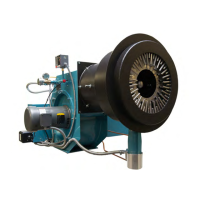
Do you have a question about the Webster JBE Series and is the answer not in the manual?
Identifies potential hazards with symbols.
Outlines essential safety practices for burner operation and maintenance.
Specifies critical steps to take before disconnecting or opening fuel lines.
Explains burner identification details and performance ratings.
Emphasizes technician qualifications and adherence to installation codes.
Covers burner capabilities, supporting documentation, and service contacts.
Details the coding system used in burner model numbers for configuration.
Introduces common components and their variations based on capacity.
Explains the function and components of the combustion air fan and windbox.
Details the burner drawer, its components, and diffuser adjustments.
Covers the gas manifold, spuds, valves, and pressure switches.
Describes oil pump, pressure regulator, and oil train components.
Explains FGR adapter, tubes, valves, and ducting for NOx reduction.
Covers linkage, jackshaft, fuel cams, and modulating motors for combustion control.
Details the control panel, flame safeguard, switches, and relays.
Covers junction boxes, potentiometers, transformers, and alarms.
Covers planning, clearances, combustion air requirements, and notification procedures.
Details installation of refractory, burner mounting, gas, and oil piping.
Covers installation for oil systems, gas pilot, and FGR duct sizing and routing.
Addresses stack connections, draft control, and electrical system installation.
Introduces common components of gas fuel systems like regulators and valves.
Covers gas pilot systems and pressure atomized oil system operations.
Details the air atomizing oil system and its components.
Details fuel-air ratio controls and electrical control components.
Explains operating controls, modulating controls, and flame safeguard functions.
Inspects burner for loose connections, fuel lines, mounting, and drawer assembly security.
Checks motor rotation and initial positions of fuel, FGR, and air controls.
Details adjustments for fuel cams and air damper for proper low fire settings.
Covers adjustments for pilot, gas pressure, oil pressure, and air proving switch.
Explains how to set operating and modulating controls for burner cycling.
Lists pre-startup checks and details linkage adjustments for valve control.
Covers fuel cam, FGR, and burner drawer adjustments for optimal combustion.
Outlines setup procedures for single fuel and combination gas/oil burners.
Details the step-by-step setup for gas, pressure atomized oil, and air atomized oil systems.
Covers adjustments for operating controls, testing limit switches, and pilot performance.
Describes normal and emergency burner shutdown, and procedures for restarting after extended periods.
Emphasizes logging, visual inspections, and maintaining fuel-air-ratio controls for reliability.
Covers inspection of gas fuel systems (interlocks, drip legs) and oil fuel systems (compressor, strainers, nozzles).
Details inspection of FGR components for corrosion and guidelines for fan/motor re-assembly.
Provides a detailed schedule for routine inspection and testing of burner components.
Addresses problems with ignition, spark, flame presence, pilot detection, and gas/oil flame failure.
Covers issues like burner stuck at low fire, unexpected shutdowns, and failure to start.
Addresses high CO, gas noise, oil smoking, and inconsistent fuel-air ratios.
Solves problems related to achieving rated capacity and maintaining consistent fuel-air ratios.
Addresses issues with air atomized oil capacity and achieving specified NOx levels on gas.